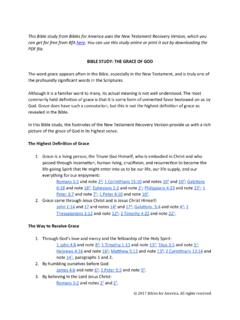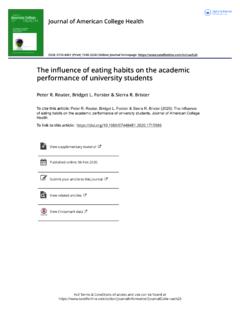Transcription of Are Ideas Getting Harder to Find? - Stanford University
1 American Economic Review 2020, 110(4): 1104 1144 Ideas Getting Harder to Find? By Nicholas Bloom, Charles I. Jones, John Van Reenen, and Michael Webb* Long-run growth in many models is the product of two terms: the effective number of researchers and their research productivity. We present evidence from various industries, products, and firms show-ing that research effort is rising substantially while research pro-ductivity is declining sharply. A good example is Moore s Law. The number of researchers required today to achieve the famous dou-bling of computer chip density is more than 18 times larger than the number required in the early 1970s. More generally, everywhere we look we find that Ideas , and the exponential growth they imply, are Getting Harder to find.
2 (JEL D24, E23, O31, O47)This paper applies the growth accounting of Solow (1957) to the production function for new Ideas . The basic insight can be explained with a simple equation, highlighting a stylized view of economic growth that emerges from idea-based growth models: Economic growth , 2% or 5% = Research productivity (falling) Number of researchers (rising) .Economic growth arises from people creating Ideas . As a matter of accounting, we can decompose the long-run growth rate into the product of two terms: the effective number of researchers and their research productivity. We present a wide range of empirical evidence showing that in many contexts and at various levels of disaggregation, research effort is rising substantially, while research productivity is * Bloom: Department of Economics, Stanford University , and NBER (email: Jones: Graduate School of Business, Stanford University , and NBER (email: Van Reenen: Department of Economics, MIT, LSE, and NBER (email: Webb: Department of Economics, Stanford University (email: Emi Nakamura was the coeditor for this article.))))
3 We are grateful to three anonymous referees for detailed comments. We also thank Daron Acemoglu, Philippe Aghion, Ufuk Akcigit, Michele Boldrin, Ben Jones, Pete Klenow, Sam Kortum, Peter Kruse-Andersen, Rachel Ngai, Pietro Peretto, John Seater, Chris Tonetti, and seminar participants at Bocconi, the CEPR Macroeconomics and Growth Conference, CREI, George Mason, Harvard, LSE, MIT, Minneapolis Fed, NBER growth meeting, the NBER Macro across Time and Space conference, the Rimini Conference on Economics and Finance, and Stanford for helpful comments. We are grateful to Antoine Dechezlepretre, Keith Fuglie, Dietmar Harhoff, Wallace Huffman, Brian Lucking, Unni Pillai, and Greg Traxler for extensive assistance with data. The Alfred Sloan Foundation, SRF, ERC, and ESRC have provided financial support.
4 Any opinions and conclusions expressed herein are those of the authors and do not necessarily represent the views of the US Census Bureau. All results have been reviewed to ensure that no confidential information is disclosed. Data and replication files can be found at Go to to visit the article page for additional materials and author disclosure ET AL.: ARE Ideas Getting Harder TO Find? VOL. 110 NO. 4declining sharply. Steady growth, when it occurs, results from the offsetting of these two the best example of this finding comes from Moore s Law, one of the key drivers of economic growth in recent decades. This law refers to the empirical regularity that the number of transistors packed onto a computer chip doubles approximately every two years.
5 Such doubling corresponds to a constant exponen-tial growth rate of 35 percent per year, a rate that has been remarkably steady for nearly half a century. As we show in detail below, this growth has been achieved by engaging an ever-growing number of researchers to push Moore s Law forward. In particular, the number of researchers required to double chip density today is more than 18 times larger than the number required in the early 1970s. At least as far as semiconductors are concerned, Ideas are Getting Harder to find. Research productiv-ity in this case is declining sharply, at a rate of 7 percent per document qualitatively similar results throughout the US economy, provid-ing detailed microeconomic evidence on idea production functions. In addition to Moore s Law, our case studies include agricultural productivity (corn, soybeans, cotton, and wheat) and medical innovations.
6 Research productivity for seed yields declines at about 5 percent per year. We find a similar rate of decline when study -ing the mortality improvements associated with cancer and heart disease. Finally, we examine two sources of firm-level panel data, Compustat and the US Census of Manufacturing. While the data quality from these samples is coarser than our case studies, the case studies suffer from possibly not being representative. We find substantial heterogeneity across firms, but research productivity declines at a rate of around 10 percent per year in Compustat and 8 percent per year in the research productivity is declining sharply within particular cases and yet not declining for the economy as a whole. While existing varieties run into dimin-ishing returns, perhaps new varieties are always being invented to stave this off.
7 We consider this possibility by taking it to the extreme. Suppose each variety has a productivity that cannot be improved at all, and instead aggregate growth proceeds entirely by inventing new varieties. To examine this case, we consider research productivity for the economy as a whole. We once again find that it is declining sharply: aggregate growth rates are relatively stable over time,1 while the number of researchers has risen enormously. In fact, this is simply another way of looking at the original point of Jones (1995), and we present this application first to illustrate our methodology. We find that research productivity for the aggregate US economy has declined by a factor of 41 since the 1930s, an average decrease of more than 5 percent per is a good place to explain why we think looking at the macrodata is insuf-ficient and why studying the idea production function at the micro level is cru-cial.
8 Section II discusses this issue in more detail. The overwhelming majority of papers on economic growth published in the past decade are based on models in 1 There is a debate over whether the slower rates of growth over the last decade are a temporary phenomenon due to the global financial crisis or a sign of slowing technological progress. Gordon (2016) argues that the strong US productivity growth between 1996 and 2004 was a temporary blip and that productivity growth will, at best, return to the lower growth rates of 1973 1996. Although we do not need to take a stance on this, note that if frontier TFP growth really has slowed down, this only strengthens our AMERICAN ECONOMIC REVIEWAPRIL 2020which research productivity is An important justification for assuming constant research productivity is an observation first made in the late 1990s by a series of papers written in response to the aggregate These papers high-lighted that composition effects could render the aggregate evidence misleading: perhaps research productivity at the micro level is actually stable.
9 The rise in aggre-gate research could apply to an extensive margin, generating an increase in product variety, so that the number of researchers per variety, and thus micro-level research productivity and growth rates themselves, are constant. The aggregate evidence, then, may tell us nothing about research productivity at the micro level. Hence, the contribution of this paper: study the idea production function at the micro level to see directly what is happening to research productivity only is this question interesting in its own right, but it is also informative about the kind of models that we use to study economic growth. Despite large declines in research productivity at the micro level, relatively stable exponential growth is common in the cases we study (and in the aggregate US economy).
10 How is this possible? Looking back at the equation that began the introduction, declines in research productivity must be offset by increased research effort, and this is indeed what we these points together, we see our paper as making three related contribu-tions. First, it looks at many layers of evidence simultaneously. Second, the paper uses a conceptually consistent accounting approach across these layers, one derived from core models in the growth literature. Finally, the paper s evidence is informa-tive about the kind of models that we use to study economic selection of cases is driven primarily by the requirement that we are able to obtain data on both the idea output and the corresponding research input. We looked into a large number of possible cases to study , only a few of which have made it into this paper; indeed, we wanted to report as many cases as possible.












